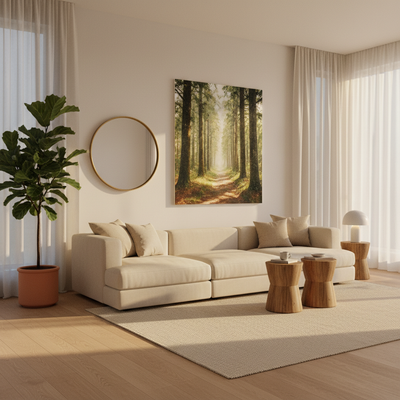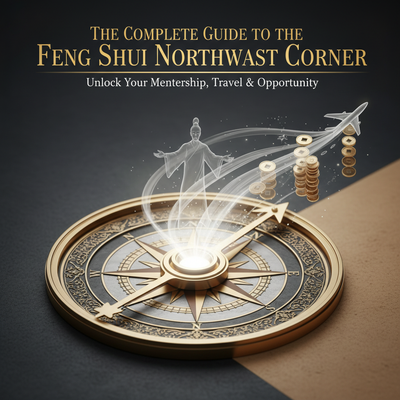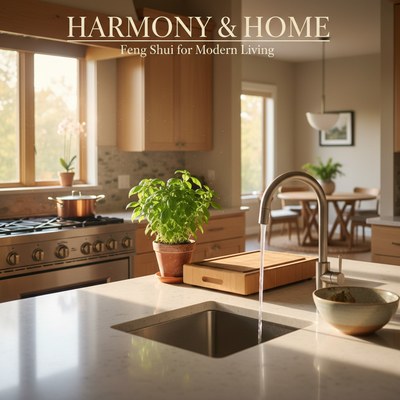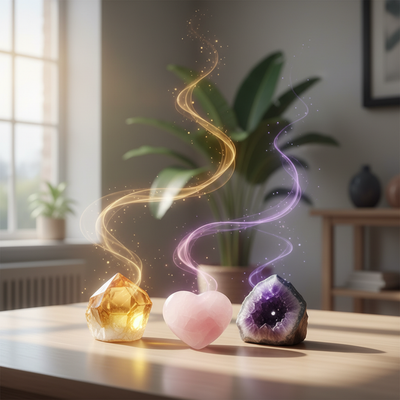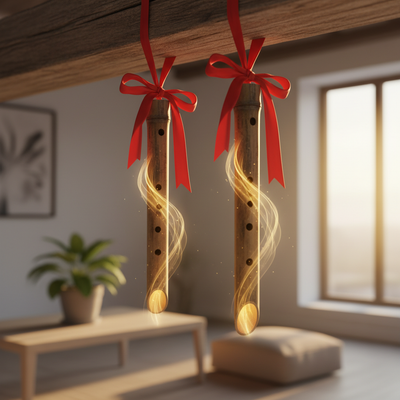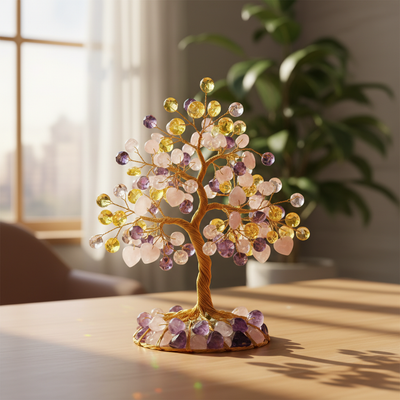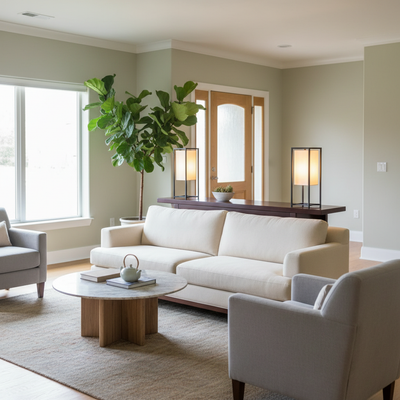Does your bedroom feel like a true escape, or is it just a room where you sleep? If you wake up feeling tired or sense something feels off in your personal space, the answer might be hanging on your walls. This guide will help you use art to transform your bedroom into a peaceful place of rest and connection. At its heart, feng shui bedroom art is about choosing images, colors, and placements that create calm, caring, and supportive energy (Qi). It's a thoughtful practice that goes way beyond simple decoration, turning your walls into active helpers for your well-being.
Why Art Matters

The basic idea of feng shui is Qi, or Life Force Energy. For a bedroom to be a restful space, this energy must be calm, gentle, and flowing smoothly. Stuck or messy Qi can lead to restlessness, poor sleep, and feeling uneasy. Your bedroom should be a place of Yin energy—the quiet, peaceful, and restoring force that balances the active, bright Yang energy of your daily life. The art you choose can either help this important Yin quality or mess it up completely.
The art in your bedroom is more than decoration; it's a constant energy conversation with your subconscious mind.
Every object carries its own energy, and the images you surround yourself with have a deep subconscious impact. Art showing struggle, loneliness, or chaos can quietly fill your space with those same qualities, affecting your mood and even your dreams. On the other hand, art that is peaceful, balanced, and uplifting creates a positive and restful environment. Understanding this lets you make conscious choices that support your well-being on a deeper level.
[A helpful visual would be a simple diagram showing two paths: one with gentle, winding arrows labeled "Flowing Qi" leading to a peaceful icon, and another with jagged, blocked arrows labeled "Stagnant Qi" leading to a stressed icon.]
Choosing Good Themes
Selecting the right imagery is the most direct way to influence your bedroom's energy. The goal is to choose art that visually and energetically represents rest, connection, and gentle growth.
Symbolism of Pairs
For a master bedroom, especially if you want to nurture a romantic partnership or attract one, art showing pairs is very important. This symbolism strengthens the energy of a committed, balanced union. A single object or figure can subconsciously promote feelings of being alone or lonely. Instead, look for imagery that celebrates partnership.
- A pair of mandarin ducks or swans, classic symbols of lifelong loyalty.
- Two blooming flowers on a single stem, representing shared growth.
- An abstract piece with two balanced, interacting shapes or forms.
- A peaceful image of a couple, shown in a way that feels loving and supportive.
Grounding with Nature
Nature scenes are powerful tools for bringing grounding, healing energy into the bedroom. However, not all nature is the same. The key is to choose scenes that are calm and stable, avoiding anything overly dramatic or chaotic.
- Peaceful landscapes with soft, rolling hills suggest stability and support.
- Lush, green forests or images of healthy, rooted trees symbolize growth and vitality.
- Blooming flowers, particularly peonies, are classic symbols of love, romance, and prosperity. Choose images with soft colors and gentle compositions.
- Avoid images of empty deserts, stormy weather, or jagged, aggressive mountains.
The Power of Abstract
Abstract art can be excellent for a feng shui bedroom, provided you choose with intention. The focus should be on the feeling the piece creates. Stay away from art with sharp, jarring lines, aggressive slashes of color, or a chaotic composition that feels unsettling. Instead, choose pieces that feature:
- Soft, flowing shapes and curves that guide the eye gently through the piece.
- A calming, harmonious color palette with blended tones. Earthy, muted, and pastel colors work exceptionally well.
- A sense of balance and harmony in the overall composition. The piece should feel resolved and peaceful, not agitating.
Aspirational Imagery
The art in your bedroom can also serve as a quiet affirmation of your goals and desires. This is the principle of "what you see is what you get." The image you see upon waking and before sleeping can set a powerful intention.
- For stability and support in life, consider a beautiful image of a solid, rounded mountain (not a sharp, intimidating peak).
- For a gentle, upward career path or personal growth, a path winding through a peaceful forest can be very effective.
- If you seek more tranquility, a still, peaceful lake at dawn can help cultivate that inner peace.
The Five Elements
In feng shui, color is not just a decorative choice; it's a way to balance the energy of a space using the Five Elements theory. Each element—Wood, Fire, Earth, Metal, and Water—corresponds to specific colors and energies. For the bedroom, the goal is to create a palette that is mainly nurturing and calming.
The most helpful elements for a bedroom are Earth and Metal, with supportive accents from Wood and Water. The Fire element, with its high-energy colors, should be used very carefully.
- Earth provides a sense of stability, grounding, and nourishment. It's the foundation of a restful space.
- Metal brings clarity, calmness, and precision. It helps quiet the mind.
- Wood offers gentle growth, healing, and vitality.
- Water relates to flow and introspection, but too much can feel overwhelming.
- Fire represents passion and high energy. While a tiny accent can support romance, too much can cause anxiety and disrupt sleep.
Here is a simple guide to balancing your art's color palette:
| Element | Associated Colors | Bedroom Energy |
|---|---|---|
| Earth | Soft yellows, sandy tones, beige, terracotta | Nurturing, Stable, Grounding |
| Metal | Whites, pastels, soft grays, metallics | Clarity, Precision, Calm |
| Wood | Greens, light teal, soft blues | Growth, Vitality, Healing |
| Water | Deep blues, black (use sparingly as accents) | Flow, Introspection |
| Fire | Reds, bright oranges, purple (use as small accents only) | Passion, High Energy (can be disruptive) |
When selecting art, consider its main colors. A landscape with soft greens (Wood) and sandy browns (Earth) is an excellent combination for a bedroom, promoting both healing and stability.
Red Flags in Art
Just as important as knowing what to choose is knowing what to avoid. Certain types of art can actively drain the positive energy from your bedroom, creating an environment that is not good for rest or romance. Be mindful and remove any art that falls into these categories.
-
Images of Single Figures: A portrait or image of a solitary person, no matter how beautiful, energetically reinforces being alone. This is especially harmful in a master bedroom for a couple or for someone seeking a partner.
-
Aggressive or Sad Imagery: This seems obvious, but it's a common mistake. Avoid any art that depicts conflict, war, struggle, crying figures, or predators. Scenes of storms, shipwrecks, or dying flowers also carry heavy, negative energy that has no place in a sanctuary.
-
Overpowering Water Features: While a gentle stream can be positive, large, powerful images of the ocean, crashing waves, or waterfalls are generally not recommended for the bedroom. The energy of so much water can feel overwhelming and create a sense of instability or emotional turmoil, leading to restless sleep. Never hang an image of water above your bed.
-
Photos of Family and Friends: Your master bedroom is a private sanctuary for you and your partner (or for your own personal rest). Having photos of family, children, or friends can create the subconscious feeling of being watched, which can interfere with intimacy and relaxation. These photos are wonderful for living rooms and family areas, but not the bedroom.

- Mirrors Facing the Bed: While not "art" in the traditional sense, mirrors are often framed and hung as decorative pieces. A mirror directly reflecting the bed is one of the biggest feng shui no-gos. It is believed to disrupt sleep by bouncing too much energy around the room and can even be said to invite third-party interference in a relationship.
Strategic Art Placement
Once you've chosen the perfect piece, where you hang it is just as important as what it shows. Proper placement activates the art's positive energy and directs it effectively.
Above Your Headboard
This is a primary power position in the bedroom. The art placed here has a direct influence on your health and your relationship, as it sits over you while you are in your most passive, receptive state. The art here should feel stable, nurturing, and supportive.
- It must be securely fastened. You should never feel a subconscious fear of it falling.
- A lightweight canvas is preferable to a heavy, glass-framed piece for this reason.
- One large, unified piece is generally better than a busy gallery wall, which can create chaotic energy above your head.
In Your Sightline
The wall opposite your bed holds the art that is the first thing you see when you wake up and the last thing you see before you sleep. This placement has a powerful effect on setting the tone for your day and your dreams. This is the ideal spot for your most aspirational or joyful piece of art—something that makes you feel happy, hopeful, and inspired.
The Relationship Corner
According to the Bagua, the energetic map of a space, the far-right corner of your bedroom from the door is the Relationship and Love area (Kun). Placing art that symbolizes partnership in this corner is a powerful way to activate and enhance romantic energy. A beautiful painting of two birds, a pair of flowers, or a loving couple is perfectly suited for this specific spot.
Matching Art to You
To take your feng shui practice a step further, you can personalize your art choices based on your unique energetic makeup. This is done using your Kua number, a figure derived from your birth year and gender that corresponds to one of the Five Elements. Aligning your environment with your personal element can create a space that is exceptionally supportive.
Step 1: Find Your Kua Number.
You can find your number using an online calculator or the simplified chart below. (For those born in Jan. or Feb., check the start date of the Chinese New Year for your birth year).
[You can find your Kua number by using a trusted Kua calculator online.]
Step 2: Identify Your Element.
Once you have your Kua number, find your corresponding element.
| Kua Number | Element |
|---|---|
| 1 | Water |
| 2, 5 (female), 8 | Earth |
| 3, 4 | Wood |
| 6, 7 | Metal |
| 5 (male) | Earth |
| 9 | Fire |
Step 3: Choose Supporting Colors.
Now, choose art with colors that either match your element or belong to the element that nourishes it in the productive cycle (Water nourishes Wood, Wood fuels Fire, Fire creates Earth, Earth produces Metal, Metal holds Water).
For example, if you are a Kua number 3, your element is Wood. You would benefit greatly from art with green and brown tones (your own Wood element) or from art with blues and blacks (the Water element, which nourishes Wood). This creates a deeply personal layer of support. If your partner has a different Kua number, aim for art that incorporates colors that support both of you or that harmonize your elements.
A Bedroom Transformation
The principles of feng shui art are not just theoretical; they create real shifts in a home's atmosphere. We recently worked with a client who felt constantly exhausted and disconnected from her partner. Her bedroom, though stylish, was working against her.
The "Before" state was energetically chaotic. Above the bed hung a large, dramatic abstract piece with sharp black lines and jarring splashes of red—a combination of aggressive energy and an overly stimulating Fire element. On the opposite wall was a chic but somber black-and-white photograph of a single, anonymous woman walking away on a foggy street.
Our process was simple but profound:
-
The Audit: We identified the art as a primary source of the unrest. The piece above the bed was too "Yang" and aggressive for sleep, while the photo opposite the bed was a powerful symbol of loneliness and departure.
-
The Replacement: We replaced the abstract art with a large, peaceful canvas print of a gentle, misty forest in soft green and earthy brown tones (Wood and Earth elements). This immediately introduced a feeling of calm and stability. The lonely figure was swapped for an elegant print of two swans gliding together on calm water, which we placed in the relationship corner of the room.
-
The Result: The client reported an immediate and noticeable change. The room felt "like it could finally breathe." She began sleeping more deeply and said the space felt more welcoming and intimate, fostering a renewed sense of connection with her partner.
Seeking Professional Guidance
While these guidelines provide a powerful framework, every home is unique. Sometimes, challenges like an irregularly shaped room, a challenging floor plan, or conflicting Kua numbers between partners require a more nuanced approach. When a general guide doesn't seem to address your specific situation, a professional consultation can provide invaluable clarity.
For these nuanced situations, an expert can create a truly custom strategy. For instance, at THE QI FLOW, our team often helps clients analyze their unique floor plan and the personal Kua numbers of everyone in the home. This allows us to recommend an art and decor plan that moves beyond generic rules to address the specific energetic dynamics at play. This ensures that the energy of the space supports the distinct goals and well-being of the entire family, creating profound and lasting harmony.
Curate Your Sanctuary
Your bedroom should be the most nurturing room in your home. By applying the principles of feng shui to your art choices, you can actively shape its energy. Remember the key takeaways: art is energy, so choose themes of love, tranquility, and gentle growth. Pay attention to color, avoid imagery that promotes negativity or loneliness, and place your chosen pieces with clear intention.
You don't need to change everything at once. Start today by evaluating just one piece of art in your bedroom. Ask yourself how it makes you feel. Trust your intuition, and begin the rewarding process of curating a personal sanctuary that truly restores your body, mind, and spirit.
